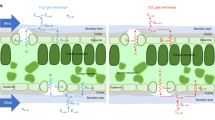Abstract
Electrical impedance spectra (80 Hz–1 MHz) in Scots pine needles were found to be characterized by spectrum skewness in the Cole-Cole plot. These spectra were subjected to analysis with two distributed models: (i) the Cole-Cole function and (ii) an equivalent circuit which takes account of the presence of air spaces within the needles (Model-A). In analysis with untreated needles (without artificial infiltration with water), Model-A fitted better than the Cole-Cole function to the experimental data. After infiltration of water into the needles, the extent of spectrum skewness was substantially decreased compared with the pre-infiltration condition and the Cole-Cole function fitted better than Model-A to the measured impedance data. The Cole-Cole α decreased from 0.47 in non-infiltrated needles to 0.42 in the infiltrated needles. The exceptionally large value of α in non-infiltrated needles can be explained by the presence of air spaces, which produce transmission line properties in the mesophyll. In support of the validity of Model-A, this new model provided specific membrane resistances of 1190 ± 83 Ω cm2 in cold hardened and non-hardened needles respectively. These specific membrane resistance are comparable with previous reports of membrane resistances in other biological systems. It is concluded that in this exceptionally spongy tissue, Cole-Cole α is likely to be due to the effects of the transmission line properties of cells which are surrounded by air spaces and only thin cell walls outside the insulating cell membranes.
Similar content being viewed by others
References
Ackmann JJ, Seitz MA (1984) Methods of complex impedance measurement in biological tissue. CRC Crit Rev Biomed Eng 11:281–311
Cole KS (1928) Electric impedance of suspensions of spheres. J Gen Physiol 12:29–36
Cole KS (1932) Electric phase angle of cell membranes. J Gen Physiol 15:641–649
Cole KS (1933) Electric conductance of biological systems. Cold Spring Harbor Symp Quant Biol 1:107–116
Cole KS (1941) Impedance of single cells. Tabulae Biol 19 (Cellula, Pt. 2):24–27
Cole KS (1968) Membranes, Ions and Impulses, University of California Press, Berkeley and Los Angeles
Davidson DW, Cole RH (1951) Dielectric relaxation in glycerine. J Chem Phys 18:1417
Foster KR, Schwan HP (1989) Dielectric properties of tissues and biological materials: a critical review. CRC Crit Rev Biomed Eng 17:25–104
Greenham CG, Groves RH, Muller WJ (1980) Variation between populations of one form of skeleton weed (Chondrilla juncea L.) shown by electrical parameters. J Exp Bot 31:967–974
Greenham CG, Randall PL, Muller WJ (1982) Studies of phosphorus and potassium deficiencies in Trifolium subterraneum based on electrical measurements. Can J Bot 60:634–644
Havriliak S, Negami S (1966) A complex plane analysis of α-dispersions in some polymer systems. J Polym Sci: Part C 14:99–117
Hayden RI, Moyse CA, Calder FW, Crawford DP, Fensom DS (1969) Electrical impedance studies on potato and alfalfa tissue. J Exp Bot 20:177–200
Kanai H, Haeno M, Sakamoto K (1987) Electrical measurement of fluid distribution in legs and arms. Med Prog Technol 12: 159–170
Macdonald JR (1987) Impedance spectroscopy — Emphasizing solid Materials and Systems. John Wiley & Sons, New York
Macdonald JR (1991) Impedance Spectroscopy. In: Meyers RA (ed) Encyclopedia of Physical Science and Technology, 1991 Yearbook. Academic Press, New York, pp 279–291
Markx GH, Davey CL, Kell DB (1991) To what extent is the magnitude of the Cole-Cole α of the β-dielectric dispersion of cell suspensions explicable in terms of the cell size distribution. Bioelectrochem Bioenerg 25:195–211
Mørkrid L, Qiao Z-G (1988) Continuous estimation of parameters in skin electrical admittance from simultaneous measurements at two different frequencies. Med Biol Eng Comput 26:633–640
Raistrick ID (1987) The electrical analogs of physical and chemical processes. In: Macdonald JR (ed) Impedance spectroscopy — Emphasizing Solid Materials and Systems. John Wiley & Sons, New York, pp 27–84
Repo T (1994) Influence of different electrodes and tissues on the impedance spectra of Scots pine shoots. Electro- and Magnetobiology 13:1–14
Repo T, Zhang MIN (1993) Modelling woody plant tissues using a distributed electrical circuit. J Exp Bot 44:977–982
Repo T, Zhang MIN, Ryyppö A, Vapaavuori E, Sutinen S (1994) Effects of freeze-thaw injury on parameters of distributed electrical circuits of stems and needles of Scots pine seedlings at different stages of acclimation. J Exp Bot 45:823–833
Schanne OF, P.-Ceretti ER (1978) Impedance measurements in biological cells. John Wiley & Sons, New York
Soikkeli S (1981) Comparsion of cytological injuries in conifer needles from several polluted industrial environments in Finland. Ann Bot Fenn 18:47–61
Thomas BJ, Cornish BH, Ward LC (1992) Bioelectrical impedance analysis for measurement of body fluid volumes: a review. J Clin Eng 17:505–510
Zhang MIN, Willison JHM (1991) Electrical impedance analysis in plant tissues: A double shell model. J Exp Bot 42:1465–1475
Zhang MIN, Willison JHM (1993) Electrical impedance anlysis in plant tissues: Impedance measurement in leaves. J Exp Bot 44:1369–1375
Author information
Authors and Affiliations
Additional information
Correspondence to: T. Repo
Rights and permissions
About this article
Cite this article
Zhang, M.I.N., Repo, T., Willison, J.H.M. et al. Electrical impedance analysis in plant tissues: on the biological meaning of Cole-Cole α in Scots pine needles. Eur Biophys J 24, 99–106 (1995). https://doi.org/10.1007/BF00211405
Received:
Accepted:
Issue Date:
DOI: https://doi.org/10.1007/BF00211405




